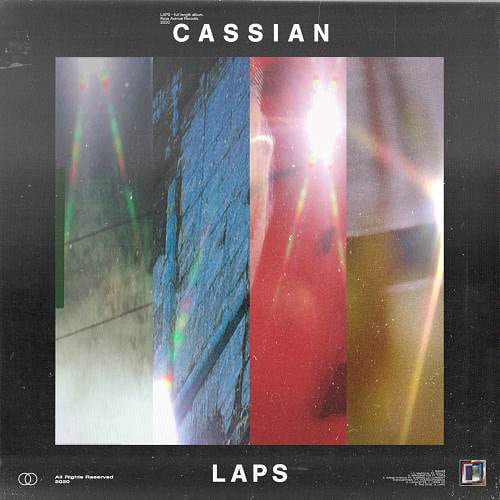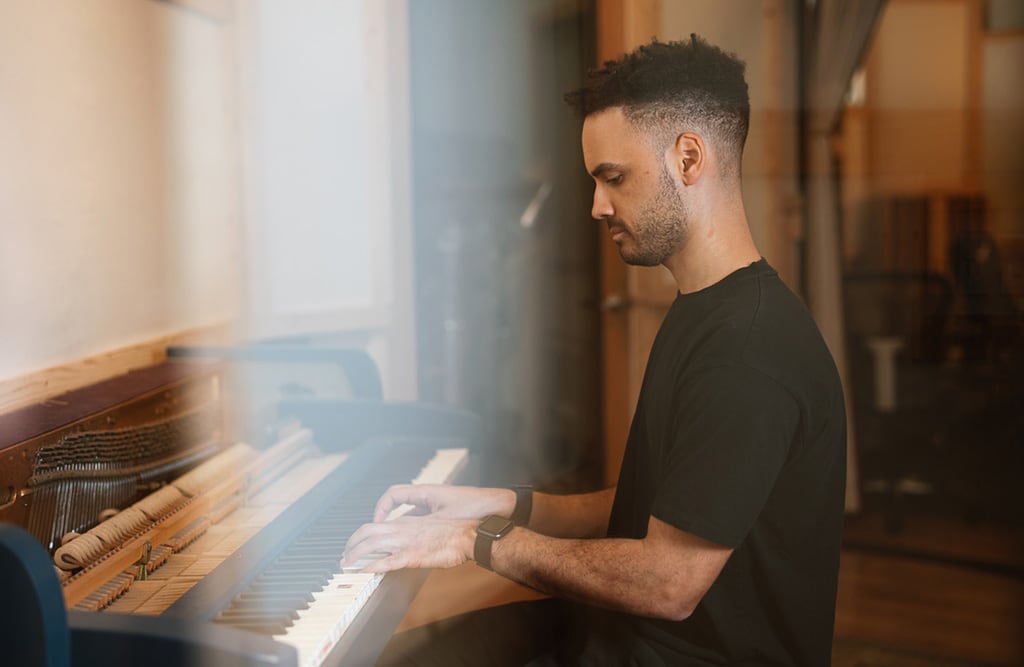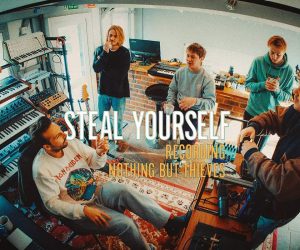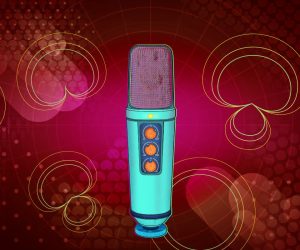
Putting in the Laps
How Cassian, a relatively unknown producer from Sydney, elevated Rüfüs du Sol’s mixes to another level and found his own sound along the way.

Artist: Cassian
Album: Laps
The first time I looked up who mixed Rüfüs du Sol’s latest album Solace, I was surprised. I’d always figured it’d be a ‘name’ guy like Tom Elmhirst, not a relatively unknown Sydney producer named Cassian with a handful of credits to his name. If it was mixed by someone in Sydney, you would put your money on it being Eric J, given much of that sound has made its way through his wheelhouse.
Tracking it back, Cassian’s name has been ‘in-the-mix’ on every Rüfüs du Sol album. For the past eight years, ever since he opened for them at Bondi’s Beach Road Hotel to a couple of hundred people, Cassian has had a box seat at the rise of one of Australia’s most successful electronic acts, Rüfüs du Sol. He’s since opened for them hundreds of times, he’s mixed the majority of their discography, they signed him to their label Rose Avenue, and they’ve become his best friends and LA neighbours. Outside of the band, and FOH engineer Cam Trewin, there’s no one as deeply involved in the sound of Rüfüs du Sol as Cassian.
SHAKY START
The relationship only materialised because of the band’s patience with an obviously talented kid. Their first single, Take Me, had been a hit and the band reached out to Cassian to remix it. “I wanted to do it but didn’t have a manager at the time and was a bad communicator,” recalled Cassian. “We were going back and forth on emails for a couple of months.” Eventually he played that Bondi gig and ‘got it’. “They were amazing. This was right when I’d started doing a few mixes for people and some production. After the show I was like, ‘I’ll do anything you guys need, I’d love to get involved.’”
The band had already mixed most of the first album, Atlas, but there was still one song, Desert Night, they hadn’t yet mixed. Cassian jumped at it.
If you listen back to Atlas – which debuted at No. 1 on the ARIA charts – it still sounds great and shows the self-made band’s remarkable capabilities on the engineering side. Still, there’s a slight strain there. It has all the key elements — extended low end, vibrant and punchy synths, and atmospherics that envelop you — but the vocal isn’t allowed to breathe in the same way it is on Cassian’s mix of Desert Night, which became their second single.
It’s a subtle difference, but ensuring Tyrone Lyndqvist’s breathy, almost whispered vocals never disappeared in the mix was a big step forward in Rüfüs du Sol’s sound. You can hear that same approach in Cassian’s debut record, Laps — released this year with appearances from guest vocalists ZOLLY (Phil Slabber of Perth’s Crooked Colours), Byron Bay’s Jo Loewenthal from TORA, LA-based Gabrielle Current, and Sydney’s Thandi Phoenix to appear — where the vocals are given this same level of attention and space.
THINNING OUT VOCALS
Cassian thinks about vocals a lot. In fact, the first thing he did the day COVID-19 restrictions eased in LA was hit the gym, grab some bread from the bakery, then head to his mate’s place to chew off his ear about vocals. He said his trick is to make vocals thinner, not bigger.
“I come from more of a dance music angle where a song has a kick with a bunch of 50Hz in it and a bunch of sub going on in the bassline,” he described. “You can’t have that big full pop vocal. The vocal needs to be a bit thinner. You have to balance the thinner vocal, but still have those intimate moments.
“When I listen to a performance and hear the melody of it — where it’s moving, what it’s doing dynamically, the frequency spectrum, and what mic it was recorded on — I get a very specific sound in mind of what I want to hit. A lot of the time, it might sound pretty different to the recording. I’m not afraid to be aggressive and do a lot of subtractive EQ.”
Cassian can really stretch his use of subtractive EQ. One of his favourite moves to get the high end where he wants, is to isolate the sweet spot of the high end, then take a big low shelf and turn everything below that point down by 6-10dB. “If I feel like it needs more of that high-end sweet spot, I’d rather turn everything else down than boost it,” he explained. “It’s just how my mind works. Where’s the sweet thing? Okay, everything else has to bow to that sweet thing.”
VOCAL COMPRESSION: LITTLE & OFTEN
He’ll compress gently, and in layers. Mostly after the fact, but the very first move is to gate and compress the vocal with a few dB of gain reduction. “Then after I tune it and do that first round of broad shaping EQ, I’ll do another round of compression that might be a little bit more aggressive, depending on the performance. A Teletronix LA2A is great for that stage of it and adds a bit of vibe as well.
“I do a bit of multi-band compression, especially on the Rüfüs stuff, but mainly as a de-esser. I’ll de-ess, then use a multi-band as well at 4 or 5k as a de-esser. Multi-band compression also helps create space for the low end without just EQ-ing out all the lows in the vocal. I’ll find where the lowest part of the melody sits, maybe it’s moving over one octave from 200Hz to 400Hz, and I’ll set a multi-band from 400Hz down to compress that range and control it without changing the tone.”
To achieve that sense of space, while maintaining intimacy, Cassian rolls off the top end of the reverb, especially in verses. “There might be a bunch of space there, but you don’t get the splashy obvious reverb-y high end. Also, pre-delays. The other day I was working on a mix and had a 60ms pre-delay. It was a bit much, and I had to tone it down, but I’m always trying to push the longest pre-delays I can get away with, which definitely helps with that upfront feeling for vocals.”
It’s just how my mind works. Where’s the sweet thing? Okay, everything else has to bow to that sweet thing

ANALYSING MELODIES WITH SPAN
With dense electronic dance mixes, crafting space for all the elements you want to feature is more than just a balancing act. Sure, at the end of the day it comes down to what you turn up, and what you don’t. But when a single stereo synth patch has the potential to eat up all your space in one swell swoop, it requires a lot of minor surgery to make sure that doesn’t happen.
Cassian thinks in a flowchart. When it comes to balancing out synth parts, rather than start with everything in, he initially goes through each part in solo. This part of his process isn’t about ignoring the whole, but laser-focusing in on each synth part’s melodic contribution. “Then when it comes back to balancing it out in the end, it’s just a matter of priorities.”
He uses Voxengo’s Span analyser, in high-res mode, to help see where the melody of each part is. “I always focus on whatever the fundamental melody frequencies are of that sound, I really try not to EQ those frequencies. If you EQ it, what you’re really doing is changing the relationship of the note. If there’s a melody that has six notes, and you EQ half of those notes down 3dB, why are you turning the notes down?”
Instead he uses Span to train his focus on the harmonics and overtones that might be taking up too much space, like a rogue D# overtone when the melody is playing a D. “As long as the melody is still there, that’s the most important thing musically.”
“It’s easy to make musical decisions with that analyser. If you’re hearing something that doesn’t sound right, and you’re looking at it, and it doesn’t look right. Then if you have a LUFS or RMS meter and it doesn’t seem right on that. Then, with certainty, I can make that decision to address it. Whereas ears can be deceiving, rooms can be deceiving. Also, if you’re just visually looking at things and making decisions purely off the meter, that’s definitely not the right way to go either.”
SPEAKING OF METERING
Cassian maintains a number of hearing/metering checks and balances throughout his mix process. His gain structure always starts with false headroom, knocking back his master fader 6dB, and keeping a self-imposed limit of ensuring any one sound in solo doesn’t exceed -6dB. “In order for that to happen, the drum bus can’t be too loud, because you’re not going to turn up your kick past that,” explained Cassian. “If you want your kick louder, then turning it up isn’t the answer. It’s a different workaround. Maybe it’s some clipping, maybe it’s a different EQ to make it feel louder without using up more peak level.”
That invisible brick wall applies to everything. In his game, even the lead vocal isn’t allowed special dispensation to rise above the rest and eclipse the -6dB limit. Same with the bass. And in his music, those three elements – kick, bass and lead vocal – will always be the loudest parts. If he keeps those in check, the rest will follow suit.
Within that structure, it’s also easy for him to reference tracks: “It’s easy to get a mastered file, turn it down 6dB, look at it through the same metering plug-ins I use and have it be directly applicable to the mixes within that structure.”
KICK DRUM: LENGTH & RMS
He’s also learnt to use RMS as a gauge for the loudness of his kick. He links mixing low end to confidence and a bit of relational know-how. Over time, Cassian has built up an internal measuring stick that relates the length of a kick to its RMS value. “A longer kick drum is going to register a higher RMS because there’s more time for those frequencies to develop. If I have a 200ms kick, I can look on the T-Racks Metering plug-in I use and know that within the structure, it’s going to hit at a certain point on that meter. I look on Span and know what it should look like, too. I’m now comfortable to know that a kick can be at a particular level depending on its length.”
If he needs to check a mix, or send a copy to a client, he can apply his own faux mastering chain with a compressor followed by a limiter. Without any adjustments, his gain structure allows it to translate well “because you’re not going 10dB into the limiter. Usually it’s 4-5dB into the limiter, at most, it’s going to be 6dB.”
As for being a little-known Aussie engineer mixing it with the likes of Spike Stent (who did one track on Rüfüs’ most recent album Solace). Cassian credits it to Australians having a slightly different skillset and mixing approach to our international counterparts. Sometimes it feels like there’s an established sound LA mixers are chasing, reckoned Cassian, that often cares less about the details and more about aggressive compression. A huge generalisation, he says, but a favourable one for Aussies.
















RESPONSES